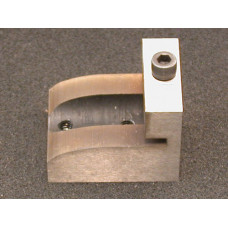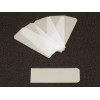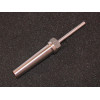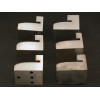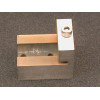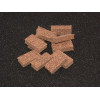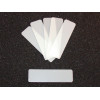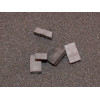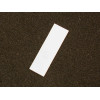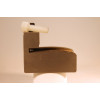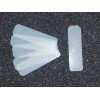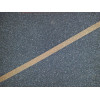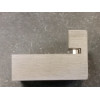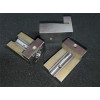This is the "original" and most popular WEBFoot public jig... the one that started the term "public jig" way back when.
All of our jigs are made from A2 tool steel and hardened to "Max-Hard" (current batch came in at 59-62Rc) to resist standard cutting tools such as files and bandsaw blades. After heat treating, each jig is cut on a Wire EDM to avoid any movement of the material during heat treating and maintain the best accuracy possible. Obviously for a public jig, this might be more accurate than necessary - but if its worth doing, its worth doing right!
These jigs are not intended to be altered with standard tools. Do not use abrasives on the jig as they can alter the jig profile (sand paper, sanding belts, grinding wheels etc.)
Need help choosing a jig? READ THIS!
| Cork Notch Height/depth: | .165" (3/16" cork) / .350" deep (old revision has a .320" deep notch). Suggested wedges/cork: 316DCC, 316HDC, 177SW, or use 162SW for double reed applications. Sand thickness for desired fit. |
| Suggested Reed: | WCDR-1,2,3,4,5,6, or SDR1 |
| Jig Bore Size: | .6245 - .626" (for 5/8 tenons) |
| Deck Height: | Measured at the front of the cork notch ≈ 0.330 - 0.335" |
| Suggested Tone Channel Dia: | 15/64" or 1/4" |
| Board Length: | Back of cork to tip of jig: 1.720" |
| Tone Channel Depth starting point: | .5" from the end of the tone board |
***As seen on the TV show "How Do They Do it?"***
This is an PARALLEL design jig. For an Upslope design use PJ2 or if you desire a longer parallel style tone board, take a look at the PJ3. Please read this description entirely before you contact us with questions.
"Upslope" means that the reed slopes upwards at the end - compared to the centerline of the keg. "Parallel" means the reed is parallel to the centerline of the keg. This jig is hardened and can not be altered with steel tools. Warranty void if altered or abused.
D1 & D2 extra reeds (D1-R-15 or D2-R15) are NOT RECOMMENDED for use with the public jig as they are very narrow reeds, and the .014" reed is a little thick for use with a single reed AR style call.
The public offering jig is a production version jig and each one is just like the other, it is not custom in any way other than when the jig was designed it was customized specifically for reproduction by Wade Carpenter. It is NOT perfect, nor does it have the same surface finish on the tone board that comes on the Custom Jigs. This is on purpose. The sound board this jig creates "straight off the jig" is marginal at best - and is on purpose. Others have said its the best "public jig" out there, but it really is up to each individual as to what they think of the sound produced directly off the jig. The public jig is not meant to create a finished product, it is to help get beyond the initial shaping stages of the sound board to get to a point at which one can start learning to make their own soundboard. The public jig is not used to create any products sold here. If you are interested in the sound the public jig creates directly from the jig, it is suggested to post up on the various call making forums for opinions from the many users of this jig. We do not have any parts cut from this jig, nor sound files of a sound board from this jig since it is not intended for "final production" of sound boards.
The public offering version is a good starting point for you to design your own soundboards. This jig is a learning tool, and not a jig designed to give a finished product. This jig will help you LEARN how to make calls, it will not make calls for you. There will be a light scribe line of both sides of the jig. This scribe line is a starting point for you to reference when locating the end of your tone channel. It is not a "set in stone" dimension, only a guide to help you get started. There are 2 tapped holes on the bottom of the jig. The intended purpose of these tapped holes (1/4-20 thread) is to allow adjustment of the keg tenon in the jig for experimenting. These take 1/4"-20 set screws (not included). These holes allow you to thread a bolt or set screw through the bottom, and to gently push up on the insert in different spots, to adjust where your base line is - for example if you were wanting to make an upslope reed design from a parallel jig, you could thread in the bolt under the cork notch and push the back up just a little. There are two set screws included with the jig, a Steel socket head cap screw and a nylon socket head cap screw (can sometimes reduce the marring to the keg from the set screw). Remember, do not sand, grind, or use carbide tools on the jig unless you are purposefully trying to alter the shape. Jigs are designed to withstand normal steel cutting tools such as files and saws. Do not use a hammer on, drop, or abuse any hardened part or tool as it may fracture and cause injury.
Remember, do not sand, grind, or use carbide tools on the jig unless you are purposefully trying to alter the shape. Our Jigs are designed to withstand normal steel cutting tools with a Rockwell hardness of 60Rc or less - less being better for the jig (typical Nicholson files are approximately 55Rc) but the jigs can NOT stand up to carbide, diamond, grinding or abrasives (like sand paper). Our jigs are through hardened A2 tool steel and are 61-64Rc hardness. We suggest avoiding tools made of material that is harder than 60Rc. Some import files have been found to be harder than the industry standard of 55-58Rc - use at your own risk. Some HSS or Cobalt tools (such as RotoZip bits etc.) can possibly be harder than 60Rc and may prematurely wear on your jig. We suggest you test any tool you use on the bottom or corner of the jig to be sure its not removing jig material prior to use on the tone board portion of your jig.
Do not use a hammer on any hardened part or tool as it may fracture and cause injury.
PJ1 - Public Duck Call Jig (Parallel)
- Brand: WEBFoot Custom Calls
- Product Code: PJ1
- Availability: 4
-
$110.00
Related Products
WCDR1 Duck Reed - Series #1 0.010" Thick (15 Pack)
WEBFoot's Series #1 Duck Reed - 0.010" Thick (15 Pack) 0.010" Thickness - 1.5" long and .575" wide..
$13.50
WCDR1 Duck Reed - Series #1 - 0.010" Thick (100 pack)
WEBFoot's Series #1 Duck Reed - 0.010" Thick (100 Pack) 0.010" Thickness - 1.5" long and .575" wid..
$75.00
Blind Mandrel .250 2MT
Blind Mandrel with No. 2 Morse Taper**. Currently only available in #2 Morse Taper. Size..
$80.00
Custom Duck Jig
PLEASE READ THIS ENTIRE PAGE: There are questions below that we require answers to in order to..
$0.00
Flat Jig - FJ - .335" deck height
Standard Flat Jig (FJ - .335" deck height) - Hardened and cut on a Wire EDM from quality tool steel...
$85.00
3/16" Cork Wedges Die Cut (10 pack)
(10 pack) 3/16" thick, .375" long and .700" wide die cut cork for AR Style duck calls This..
$3.00
WCDR2 Duck Reed - 0.010" - Series #2 (15 Pack)
WEBFoot's Series #2 Duck Reed (15 Pack) 0.010" Thickness - 1.75" long and .510" wide with 45° dog ..
$13.50
WCDR2 Duck Reed - 0.010" - Series #2 (100 pack)
WEBFoot's Series #2 Duck Reed (100 Pack) 0.010" Thickness - 1.75" long and .510" wide with 45° dog..
$75.00
3/16" Cork Wedges Die Cut (100 pack)
(100 bulk pack) 3/16" thick, .375" long and .700" wide die cut cork for AR Style duck calls ..
$27.00
177SW-10 Sanoprene Wedges .177" thick (10 pack)
(10 pack) .177" height, .355" long for AR Style duck calls - Thickness is for single reed use ..
$4.50
SDR1-15 Duck Reed - Plain (15 Pack)
Plain Duck Reed (15 Pack) - Rectangle - No dog ears 0.010" Thickness - 1.655" long and .520" wide...
$7.50
SDR1-100 Duck Reed - Plain (100 Pack)
Plain Duck Reed (100 Pack) - Rectangle - No dog ears 0.010" Thickness - 1.655" long and .520" wide..
$35.00
162SW-10 Sanoprene Wedges .162" Thick (10 pack)
(10 pack) .162" heigh, .355" long for AR Style duck calls - Thickness is for double reed use w..
$4.50
162SW-100 Sanoprene Wedges .162" Thick (100 pack)
(100 pack) .162" height, .355" long for AR Style duck calls - Thickness is for double reed use..
$38.00
177SW-100 Sanoprene Wedges .177" thick (100 pack)
(100 pack) .177" height, .355" long for AR Style duck calls - Thickness is for single reed use..
$38.00
PJ2 - Public Duck Call Jig (Upslope)
All of our jigs are made from tool steel and hardened to 61-64Rc or greater (prior to cutting the so..
$110.00
WCDR3 Duck Reed - Series #3 - 0.010" Thick (100 pack)
WEBFoot's Series #3 Duck Reed - 0.010" Thick (100 Pack) 0.010" Thickness - 1.75" long and .51..
$75.00
WCDR3 Duck Reed - Series #3 - 0.010" Thick (15 Pack)
WEBFoot's Series #3 Duck Reed - 0.010" Thick (15 Pack) 0.010" Thickness - 1.75" long and .510" wid..
$13.50
3/16" High Density Cork Strip (.330-.365" x .1875" x 9")
3/16" thick, width can vary from .330-.365" wide and 9" long - high density cork for duck calls. T..
$5.25
WCDR4 Duck Reed - Series #2 - 0.014" Thick (100 pack)
This is the same reeds a WEBFoot's Series #2 Duck Reed - but it is 0.014" thick For use as the..
$75.00
WCDR4 Duck Reed - Series #2 - 0.014" Thick (15 pack)
This is the same reeds a WEBFoot's Series #2 Duck Reed - but it is 0.014" thick For use as the..
$13.50
WCDR5 Duck Reed - Series #3 .014" (100 pack)
Picture Coming soon! WEBFoot's Series #3 Duck Reed in 0.014" thick (100 Pack) 0.0..
$75.00
WCDR5 Duck Reed - Series #3 - .014" (15 Pack)
WEBFoot's Series #3 Duck Reed (15 Pack) in 0.014" thickness 0.014" Thickness - 1.75" long and .510..
$13.50
Flat Jig - FJ.35 (.350" Deck Height)
"Tall" Deck Flat Jig (FJ.35) - Hardened and cut on a Wire EDM from quality tool steel. If you ..
$85.00
WCDR6 Duck Reed - Series #1 - 0.014" Thick (100 pack)
WEBFoot's Series #1 Duck Reed - 0.014" Thick (100 Pack) 0.014" Thickness - 1.5" long and .575" wid..
$75.00
WCDR6 Duck Reed - Series #1 - 0.014" Thick (15 Pack)
WEBFoot's Series #6 Duck Reed - 0.014" Thick (15 Pack) 0.014" Thickness - 1.5" long and .575" wide..
$13.50
Custom Flat Jig
Our blank, your flat jig design! Get just what you want to get where you're wanting to go!!! ..
$0.00
Flat Jig - FJcut - Cutdown Style
Please read the description prior to ordering. We are out of the specific FJCut blanks (FJCut en..
$100.00
Duplicate Custom Duck Jig
We are low on jig blanks, please check with us prior to ordering. A new batch of blanks ..
$0.00
Tags: PJ1

